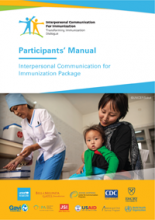
The Participant’s Manual on Interpersonal Communication for Immunization (IPC/I) and its companion Facilitator’s Guide are designed to help FLWs acquire the knowledge, skills, and attitudes needed to communicate effectively with caregivers and communities about childhood immunization. The information and exercises they contain can be used in the context of pre-service training, training workshops, day-to-day supervision, supportive supervision visits, on-the-job training (including coaching, mentoring, and peer-to-peer mentoring), and self-study. The Facilitator’s Guide was developed for group training, while the Participant’s Manual can be used in group training settings or for self-study. Workshop participants can use the Manual during training as a tool to facilitate learning and adoption of new attitudes, beliefs, and behaviors. After the training or if used for self-study, participants can use the Manual can as a reference document.
The primary audience for this manual is FLWs, however, supervisors of immunization FLWs also can benefit from conducting, participating in, or observing an IPC/I group training – doing so will improve their ability to support FLWs to consistently practice good IPC/I. At a minimum, supervisors should review the manual and observe the opening session and the closing sessions that review what participants learned.
To improve IPC skills for immunization, the full workshop outlined in this guide addresses the following topics: principles of interpersonal communication; exploring provider perspectives and barriers; problem solving; immunization and vaccines; profiling types of caregivers; community engagement; addressing negative rumors, myths, and misconceptions; and action planning. This guide recommends the use of adult learning principles and methodologies, interactive approaches, learning by doing, blended learning, gaming, role plays and demonstrations, and the use of videos to model and assess verbal and nonverbal communication.
